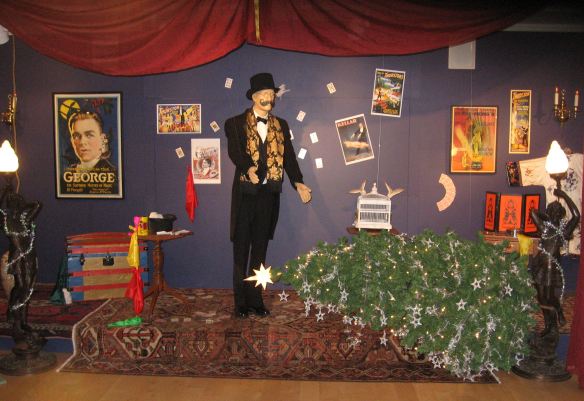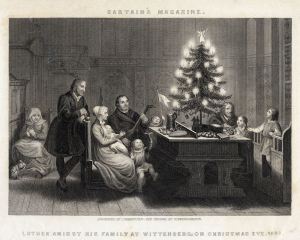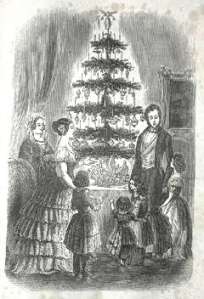
A Festival of Christmas Trees.
Christmas! That most wonderful time of year! The holidays start early here on Nantucket Island, with our annual Christmas stroll celebrated on the first weekend of December. To get us all in the mood, and start the season off with the right festive bang, we have the Nantucket Historical Association’s magical Festival of Trees. Now in its 20th year, the Festival presents over 90 Christmas trees designed and decorated by a wide variety of people and organizations from our community, nestled and overflowing throughout our historic Whaling Museum. Holiday magic indeed!

I am completely crazy about Christmas Trees (it’s a German thing), so of course I am a huge fan of this festival … in fact my wife and I Chaired the event for the last two years and remain on the committee. The Antiques Depot has been putting up a tree in the museum for about ten years now, each one telling a specific tale. Of course Christmas trees weren’t always this expansive… not even in my family where we used to put up seven different trees… and more decorated outside!
Christmas trees began rather simply, as far as we can tell, long before Christmas itself. No one appreciates nature and greenery like the pagans: the ancient Romans used evergreen boughs to decorate their temples during the feast of Saturnalia; the druids worshiped under oak trees and favored mistletoe; and the Germanic tribes and Scandinavians brought pine and fir branches and trees into their homes for a little life during the winter solstice.

During the Middle Ages clergymen, and later traveling bands of minstrels, performed Mystery or Miracle Plays to illustrate simple tales from the Bible: those telling about Adam and Eve, their fall from grace, and the promise of a coming savior became associated with Advent. In Germany and France these plays often employed a Paradise Tree decorated with apples, and perhaps holy wafers. In fact the first documented use of a tree at Christmas and New Year celebrations was around 1510 in the far northern Germanic territory around Riga or Tallinn. This was most likely a Paradise Tree rather than a proper Christmas Tree, and after a ceremony it was burnt (like a forerunner of a Yule Log). By the end of the century Germans were parading a festive tree through the streets, often followed by a man on horseback dressed a bishop… good old St. Nicholas we presume.

The first proper Christmas Tree, where a fir was brought inside a house and lit with candles, we attribute to Martin Luther in the mid 16th Century, who was said to have likened the tree to the heavenly sky from whence the Christ Child came down to earth on Christmas Eve. Germans love a party, and Luther’s simple tree soon came to be decorated with gold covered apples, sugared plums, cherries and pears, nuts, dates, pretzels, paper flowers, gingerbread figures and dough fashioned into the likeness of various animals. Atop the early trees were at first a Christ Child, and in time the angel which brought forth good tidings, or the star which led the Wise men. And once the glass makers got involved, we were well and truly off and running!

Christmas trees (even Christmas in general) had a rough time taking route in America. The Protestant establishment throughout the colonies had a grim view of Christmas, and the Puritans banned the holiday outright in New England. Hessian soldiers are believed to have celebrated with Christmas trees during the American Revolutionary War, and certainly German immigrants brought the custom with them to Pennsylvania, Ohio, and wherever else they settled. But the custom spread slowly. Even by the mid 19th Century America still wasn’t in the Christmas spirit: schools stayed open on Christmas Day, and ministers wouldn’t allow any such “pagan” trappings within their churches.

The Christmas Tree didn’t become popular in Great Britain until Queen Victoria’s German husband Prince Albert decorated a Christmas Tree in Windsor Castle.A drawing of the event published in the Illustrated London News in 1848, and republished in Godey’s Lady’s Book in 1850 (with the Queen’s crown and the Prince’s mustache removed to appear more “American”) went a long way in popularizing Christmas Trees in both the UK and the US. When a generous dash of Dickens was added to the punch… well, Christmas was here to stay.
Christmas Trees are now every-where, even in households that don’t celebrate Christmas. Artificial trees have come to rival natural trees in popularity and over the last century their ornamentation has continued to evolve, reflecting the times in which they live. And there is perhaps no better place to see this in all its wonder and glory, than in the Festival of Trees on Nantucket.

_____________________________________________________________
Visit www.nantucketchronicle.com/ , your free online resource for everything Nantucket. By Nantucketers, for Nantucketers.
______________________________________________________________________________
Please excuse any annoying advertisements that may appear below this. The intrusion is on the part of the hosting site, and is in no way endorsed by the Antiques Depot.
______________________________________________________________________________
